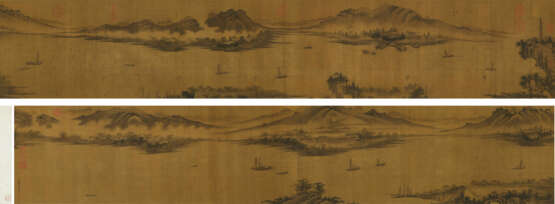ID 1086754
Lot 868 | ZOU YIGUI (1686-1772)
Valeur estimée
HKD 6 000 000 – 8 000 000
Sailing after the Rain
Handscroll, ink and colour on silk
32 x 358 cm. (12 5⁄8 x 140 7⁄8 in.)
Signed, with three seals of the artist
Eleven collector’s seals: eight of Emperor Qianlong (1711-1799), one of Emperor Jiaqing (1760-1820), one of Emperor Xuantong (1906-1967) and one other on the endpiece
Literature
Combined Catalogues of the Qing Imperial Collection Volume 5: Catalogue of the Paintings and Calligraphy in the Imperial Collection Part III (Shiqu Baoji Xubian), Vol. 3, Shanghai Bookstore, Shanghai, October 1988, p.1791.
First Inventory Book of Paintings and Calligraphy in the Palace 3, Qing Court Households Committee, 1925, p.108.
Four Catalogues on Lost Books, Paintings and Calligraphy of the Palace Museum, List of Paintings and Calligraphy Granted to Pu Jie, Beijing National Palace Museum, Beijing, September 1934, p.18.
Yang Renkai, Chronology of Lost National Treasures, Liaohai Publishing House, Shenyang, July 1999, p.380.
Zhu Zhuyu ed., Dictionary of Names of Chinese Painters, People’s Fine Art Publishing, Beijing, 2003, p.1545.
J. C. Ferguson and Rong Gen ed., Record of Documented Paintings, Beijing Library Publishing, Beijing, June 2007, p.744.
Yang Renkai, Record of Reviewed Chinese Classical Paintings and Calligraphy, Liaoning People’s Publishing House, Shenyang, June 2019, p.401.
Further details
Aesthetics In Common: The Emperors’ Artworks and Imperial Collection of Paintings and Calligraphy
Since ancient China, preserving and recording historical books and documents had been a faithful operation in the imperial household, performed by officials in the Bright Hall and the Gold Depository of the Qin dynasty, the Stone Canal Pavilion of the Han period, and the Grand Literature Chamber in Tang dynasty etc. A devoted painter and calligrapher, Emperor Huizong of the Song period established the Imperial Painting Academy to gather the best artists of the time, and ordered to compile the monumental Xuanhe Catalogues of Paintings and Calligraphy, which became the model of archiving the vast imperial collections. This was followed by the Emperor Qianlong, who command to compile Treasures of the Stone Canal Pavilion in 1744 and made available a colossal amount of other literatures like The Xiqing Compilation of Antiquities, The Emperor’s Rare Books, and Treasures of the Stone Canal Pavilion II.
Through the important Magpies and Spring Flowers attributed to Emperor Huizong (Lot 863), and the three masterpieces by Emperor Qianlong - Paintings after Ni Zan (Lot 864), Calligraphy in Running Script (Lot 865) and Replanted Wutong Studio (Lot 832), we can learn about the sensational virtuosity of the two emperors.
Masterworks from the imperial collections include Wen Boren’s Resting in the Verdant Mountain (Lot 862), with Emperor Qianlong’s inscription and five of his seals, which suggest it could possibly be a shortlisted work to be featured in Treasures of the Stone Canal Pavilion. Qian Weicheng’s Blooming Flowers (Lot 866) was created for the emperor’s pleasure. While Jiang Tingxi’s six leaves of An Imperial Manual of Birds – Roosters (Lot 867) should probably be part of the albums as recorded in Treasures of the Stone Canal Pavilion, Zou Yigui’s Sailing after the Rain (Lot 868) was catalogued in Treasures of the Stone Canal Pavilion II. Lastly, Section of the Imperial Birthday Celebration (Lot 869) depicted part of the grand observance of the 60th birthday of Emperor Kangxi.
| Artiste: | Zou Yigui (1686-1772) |
|---|
| Artiste: | Zou Yigui (1686-1772) |
|---|
| Adresse de l'enchère |
CHRISTIE'S 18 Chater Road Central Hong Kong Hong Kong | ||||||||||||||
|---|---|---|---|---|---|---|---|---|---|---|---|---|---|---|---|
| Aperçu |
| ||||||||||||||
| Téléphone | +85227601766 | ||||||||||||||
| Fax | +852 2760 1767 | ||||||||||||||
| Conditions d'utilisation | Conditions d'utilisation | ||||||||||||||
| Heures d'ouverture | Heures d'ouverture
|





